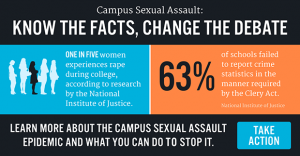Grassroots activism, regarding sexual assault, seeks to motivate students to bring change to their campuses. Change can only occur, however, through administrative and governmental cooperation. Max Lewontin and Harvey Taylor explain steps taken by the Board of Education to curb sexual assault on campuses and what administrators are doing to combat this epidemic. Taylor outlines the new surveys that are being created to gauge sexual assault on the nation’s campuses. They hope that with the information the surveys can provide, schools can get a better understanding of the scope of the issue and how to deal with it.40 Lewontin elaborates on the new rules set forth by the Department of Education on how to train students and teachers to address sexual assault and how to reorganize disciplinary hearings following a complaint.41
In regards to sexual assault, Taylor argues that “gauging students experiences and perceptions can inform colleges of common problems and how they occur.”42 One of the largest problems facing the stop of campus sexual assault, is that, far too often, it goes unreported. This makes it so that administrators don’t understand the scope of the issue and how to properly address it. Surveys, researchers think, are an incredibly valuable first step in understanding the problem and finding ways to fix it. Colleges are required to collect and report crime, however, because sexual assault is often underreported, surveys may be more effective in reflecting the reality of crime on college campuses. Beyond the argument that the surveys provide a greater understanding of the nature of sexual assault, some propose that they create a safer environment by simply raising awareness and putting sexual assault on students’ and administrators’ radar. Some argue that surveys are an “oversimplified solution to a complex problem”43 and that the government should put more energy towards prevention and education problems. Regardless, surveys are an important first step in realizing the problem, understanding how to properly address it, and raising awareness.

Recent federal rules have been released regarding how to handle campus sexual assault and make schools safer. The rules require students and employees to be trained on how to prevent sexual assault. They also contain categories for identifying hate crimes and specify that students are allowed to have and choose an advisor, such as a lawyer, in the case of campus disciplinary hearings. The main goals of the new rules are to make campuses safe spaces and to improve transparency on how colleges deal with sexual assault. They also seek to universalize the proceedings following a report of sexual assault and protect students rights and health. These rules prove the effectiveness of activism as “the final regulations come as colleges, under pressure from activists and government officials, are grappling with their legal responsibility to investigate and respond to students’ reports of sexual violence.”44
These steps prove the importance of raising awareness and staying active. Through the efforts of activists, such as government officials, grassroots programs, students, and teachers, measures are being taken on a national level to provide a safe environment for students to learn in. Surveys represent an important first step in understanding the issue at hand and the new rules put in place reflect an effort of the Department of Education to interpret the data received from the surveys and respond accordingly. One can only hope that schools and administrators comply satisfactorily with these measures.
Images taken from:
(in order of appearance)
